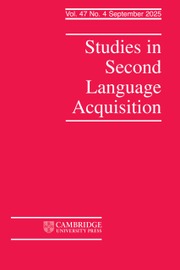Crossref Citations
This article has been cited by the following publications. This list is generated based on data provided by
Crossref.
Barreiro Bilbao, Silvia Carmen
1970.
Perception of voicing in English fricatives by Spanish listeners.
Círculo de Lingüística Aplicada a la Comunicación,
Vol. 69,
Issue. ,
p.
33.
Morrison, Geoffrey Stewart
2005.
AN APPROPRIATE METRIC FOR CUE WEIGHTING IN L2 SPEECH PERCEPTION: Response to Escudero and Boersma (2004).
Studies in Second Language Acquisition,
Vol. 27,
Issue. 04,
Boersma, Paul
and
Escudero, Paola
2005.
MEASURING RELATIVE CUE WEIGHTING: A Reply to Morrison.
Studies in Second Language Acquisition,
Vol. 27,
Issue. 4,
p.
607.
Neri, Ambra
Cucchiarini, Catia
and
Strik, Helmer
2006.
Selecting segmental errors in non-native Dutch for optimal pronunciation training.
IRAL - International Review of Applied Linguistics in Language Teaching,
Vol. 44,
Issue. 4,
Fennell, Christopher T.
Byers‐Heinlein, Krista
and
Werker, Janet F.
2007.
Using Speech Sounds to Guide Word Learning: The Case of Bilingual Infants.
Child Development,
Vol. 78,
Issue. 5,
p.
1510.
Trofimovich, Pavel
Gatbonton, Elizabeth
and
Segalowitz, Norman
2007.
A DYNAMIC LOOK AT L2 PHONOLOGICAL LEARNING: Seeking Processing Explanations for Implicational Phenomena.
Studies in Second Language Acquisition,
Vol. 29,
Issue. 03,
Boersma, Paul
2007.
Some listener-oriented accounts of h-aspiré in French.
Lingua,
Vol. 117,
Issue. 12,
p.
1989.
Morrison, Geoffrey Stewart
2008.
L1-Spanish Speakers' Acquisition of the English /i /—/I/ Contrast: Duration-based Perception is Not the Initial Developmental Stage.
Language and Speech,
Vol. 51,
Issue. 4,
p.
285.
Field, John
2008.
Guest editor’s introduction Emergent and divergent: A view of second language listening research.
System,
Vol. 36,
Issue. 1,
p.
2.
Cardoso, Walcir
2008.
Barbara O. Baptista and Michael Alan Watkins. 2006. English with a Latin beat: Studies in Portuguese/Spanish — English interphonology. In the series Studies in Bilingualism 31. Philadelphia: John Benjamins. Pp. vi + 214. US $126.00 (hardcover)..
Canadian Journal of Linguistics/Revue canadienne de linguistique,
Vol. 53,
Issue. 1,
p.
113.
Hayes-Harb, Rachel
and
Masuda, Kyoko
2008.
Development of the ability to lexically encode novel second language phonemic contrasts.
Second Language Research,
Vol. 24,
Issue. 1,
p.
5.
Kang, Yoonjung
2008.
Interlanguage Segmental Mapping as Evidence for the Nature of Lexical Representation.
Language and Linguistics Compass,
Vol. 2,
Issue. 1,
p.
103.
Detey, Sylvain
and
Nespoulous, Jean-Luc
2008.
Can orthography influence second language syllabic segmentation?.
Lingua,
Vol. 118,
Issue. 1,
p.
66.
Boersma, Paul
and
Hamann, Silke
2008.
The evolution of auditory dispersion in bidirectional constraint grammars.
Phonology,
Vol. 25,
Issue. 2,
p.
217.
Morrison, Geoffrey Stewart
2009.
L1-Spanish Speakers’ Acquisition of the English /i/—/ / Contrast II: Perception of Vowel Inherent Spectral Change1.
Language and Speech,
Vol. 52,
Issue. 4,
p.
437.
Morrison, Geoffrey Stewart
and
Kondaurova, Maria V.
2009.
Analysis of categorical response data: Use logistic regression rather than endpoint-difference scores or discriminant analysis.
The Journal of the Acoustical Society of America,
Vol. 126,
Issue. 5,
p.
2159.
Tsukada, Kimiko
2009.
Durational Characteristics of English Vowels Produced by Japanese and Thai Second Language (L2) Learners.
Australian Journal of Linguistics,
Vol. 29,
Issue. 2,
p.
287.
Escudero, Paola
Benders, Titia
and
Lipski, Silvia C.
2009.
Native, non-native and L2 perceptual cue weighting for Dutch vowels: The case of Dutch, German, and Spanish listeners.
Journal of Phonetics,
Vol. 37,
Issue. 4,
p.
452.
Baker, Wendy
and
Smith, Laura Catharine
2010.
The Impact of L2 Dialect on Learning French Vowels: Native English Speakers Learning Québécois and European French.
The Canadian Modern Language Review,
Vol. 66,
Issue. 5,
p.
711.
MAYR, ROBERT
and
ESCUDERO, PAOLA
2010.
Explaining individual variation in L2 perception: Rounded vowels in English learners of German.
Bilingualism: Language and Cognition,
Vol. 13,
Issue. 3,
p.
279.

